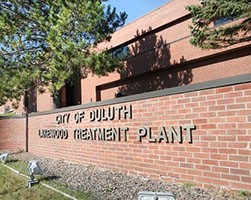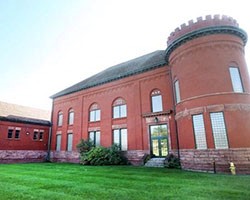Water
The City of Duluth owns, operates, and maintains the Lakewood Water Treatment Plant, 15 water reservoirs, 11 water pumping stations, and over 400 miles of water distribution pipeline. The City treats, stores, and delivers about 5 billion gallons of potable water to over 30,000 customers per year, which includes the cities of Hermantown, Proctor, and Rice Lake. The water system can store approximately 68 million gallons of water in its reservoirs.
In 1912, the City started adding chlorine to the water to aide in cleaning the water. The chlorine was applied to the water in the Pump Station and was the only treatment done to purify the water until the Treatment Plant was built in 1976. Prior to the construction of the Treatment Plant, if the water was too dirty to treat with chlorine alone, the pumps would be stopped and the 70 million gallon capacity distribution system would be drawn down for a day or so until the lake had cleared up sufficiently to resume operations. This was obviously not an ideal way to treat drinking water for a population of around 100,000 people, so a rapid sand filtration plant was built across the highway from the pump station to accomplish this.
Today the Lakewood Water Treatment Plant provides an average of about 13 million gallons of treated drinking water per day. An expansion completed in 1992 allows it to provide a maximum of about 68 million gallons of treated water per day. Every gallon of water processed at the Lakewood Plant surpasses EPA and State of Minnesota regulations for drinking water. When the water is ready to be pumped into the first portions of the distribution and reservoir system, pumps in the 1895 Pump Station push the water on its way. A series of booster pumps and a tiered system of reservoirs and tanks bring that water to neighborhoods as far apart as Lester Park and Fond Du Lac or Proctor and Park Point.


The Lakewood Water Treatment Plant is located on the north shore of Lake Superior just north of Duluth. Since 1898, all of Duluth's drinking water has been drawn from this location. Before 1898, Duluth's drinking water was mostly drawn from a location near 15th Ave E, along with a smaller intake at 5802 London Rd.
The Lakewood Water Treatment Plant cost about $6.3 million with the majority of the cost funded by State and Federal grants. The main reason for building the plant was to provide a safe, reliable source of drinking water for Duluth and the three other communities it supplies water to: Hermantown, Proctor and Rice Lake.
If you have questions or want to report a water issue, please contact the Utility Operations office at 218-730-4130 or use the online Resident Problem Reporter Application.
